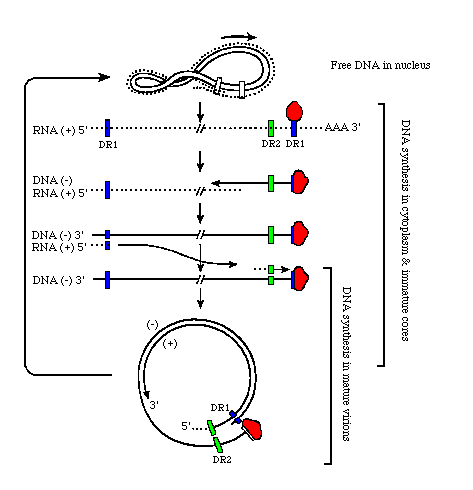
Replication of Viral Genome
The 3.5 kb (+)mRNA strand (which encodes for C and P proteins) also serves as an intermediate in viral replication! Protein P (a.k.a. as Reverse Transcriptase) attaches to the 5' end of the strand and serves as a primer for the synthesis of the first strand of DNA (unlike retroviruses, where tRNA is used). Please refer to diagram below throughout description.
DNA synthesis takes place in capsids, therefore step one is to insert the 3.5 kb mRNA into the capsid. C and P proteins are required for the encapsidation, and thus translation must first occur before replication. P first binds to the 5' end of the mRNA strand on a region called ε. C is then recruited and capsid assembles. In the absence of P, C packages any RNA; thus, C's interaction with P ensures that viral RNA is packaged into the capsid.
In the nucleocapsid, P is transferred to a site (DR1) at the 3' end of the RNA. Reverse transcription then ensues in the 5'--> 3' direction until the 5' end of the RNA is reached. As replication occurs, the RNAase activity of P releases the mRNA strand. Once this (-)DNA strand has been replicated, P then jumps to a region on the newly synthesized DNA strand called DR2, which is located close to the DR1 site 5' end of the newly synthesized strand. P brings along a small 18 nucleotide, capped region from the 5' end of the RNA which RNAase does not destroy, and uses it as a primer for the synthesis of the second (+)DNA strand. Because DR2 is farther downstream than DR1, the second (+) DNA strand to be synthesized is slightly shorter than the first. Also, second-strand synthesis is usually not complete so that the genomic double strand DNA has a single strand gap of variable length.

Picture courtesy of http://www.stanford.edu/group/virus/hepadna/index.html
Some copies of the resulting viral DNA genome are transported back into the nucleus to amplify the replication cycle. This allows for the accumulation in the nucleus of about 20 copies of viral DNA to serve as templates for mRNA synthesis. Although, this is only thought to occur early in the infection when there has yet to be a large accumulation of S protein.